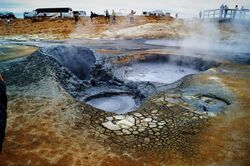Earth:Mudpot
File:Mudpot at Lassen Volcanic National Park in August 2019.webm

A mudpot, or mud pool, is a type of acidic hot spring, or fumarole, with limited water. It usually takes the form of a pool of bubbling mud, as a result of the acid and microorganisms decomposing surrounding rock into clay and mud.
Description
The mud of a mudpot takes the form of a viscous, often bubbling, slurry. As the boiling mud is often squirted over the brims of the mudpot, a form resembling a mini-volcano of mud starts to build up, sometimes reaching heights of 1 to 1.5 meters.[1] Although mudpots are often called "mud volcanoes", true mud volcanoes are very different in nature. The mud of a mudpot is generally of white to greyish color, but is sometimes stained with reddish or pink spots from iron compounds. When the slurry is particularly colorful, the feature may be referred to as a paint pot.[2]
Geology
Mudpots form in high-temperature geothermal areas where water is in short supply. The little water that is available rises to the surface at a spot where the soil is rich in volcanic ash, clay, and other fine particulates. The thickness of the mud usually changes along with seasonal changes in the water table.[3][4]
Notable sites
The geothermal areas of Yellowstone National Park contain several notable examples of both mudpots and paint pots, as do some areas of Azerbaijan, Iceland, New Zealand and Nicaragua.
Several locations in and around the Salton Sea in California are also home to active mudpots,[5] including the moving Niland Geyser.[6][7] In the case of Niland Geyser, its name is somewhat of a misnomer, as the release of carbon dioxide by seismic activity from the nearby San Andreas Fault is responsible for its behaviour, rather than through geothermal activity. The fluid contained within it is near background temperature rather than boiling, measuring around 80 °F (27 °C).[8]
Photo gallery
Short video of mud pool activity near Waiotapu, New Zealand
Video of mud pool at Orakei Korako, New Zealand
References
- ↑ Kleinschmidt, Janice (28 February 2006). "Sea of Wonders". Palms Springs Life. http://www.palmspringslife.com/sea-of-wonders/.
- ↑ Chilton (1916). "Death Valley Dodge with O.K. Parker st the Wheel". Motor Agr. https://books.google.com/books?id=vn1CAQAAMAAJ&q=death+valley+paint+pot&pg=RA11-PA20. Retrieved 21 January 2017.
- ↑ "Mudpots - Old Faithful Virtual Visitor Center". https://www.nps.gov/features/yell/ofvec/exhibits/treasures/thermals/mudpots/mudpotseasons.htm.
- ↑ Lynch, D. K.; Hudnut, K. W. (2008-08-01). "The Wister Mud Pot Lineament: Southeastward Extension or Abandoned Strand of the San Andreas Fault?" (in en). Bulletin of the Seismological Society of America 98 (4): 1720–1729. doi:10.1785/0120070252. ISSN 0037-1106. https://authors.library.caltech.edu/12061/1/LYNbssa08.pdf.
- ↑ Laflin, Patricia B.. "The Salton Sea: California;s Overlooked Treasure — Chapter 8 — Mudpots, Geysers and Mullet Island". San Diego State University. http://www.sci.sdsu.edu/salton/PeriscopeSaltonSeaCh7-9.html.
- ↑ Francuch, Dean G; Deane, Travis; Zamora, Carol (2019). "The meandering Mundo Mud Pot: Or how Salton Sea tectonics affect international trade". Proceedings of the 70th Highway Geology Symposium: 439-456. https://trid.trb.org/view/1692604.
- ↑ Andrews, Robin George (November 9, 2018). "A bubbling pool of mud is on the move, and no one knows why". National Geographic. https://www.nationalgeographic.com/science/article/bubbling-pool-mud-moving-california-dont-know-why-geology.
- ↑ "A San Andreas fault mystery: The 'slow-moving disaster' in an area where the Big One is feared" (in en-US). 2018-11-01. https://www.latimes.com/local/lanow/la-me-ln-niland-mud-pot-20181101-story.html.
External links
- Mudpots at Yellowstone National Park official site
- Mudpots photo gallery at Yellowstone NP official site
 |








